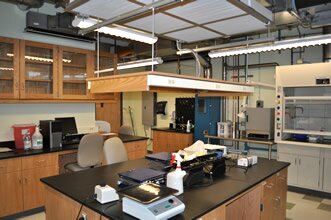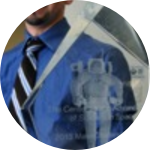About This Project
Impaired driving is the leading cause of automotive accidents and today only alcohol is legally tested and enforced in the US. As medical and recreational use of marijuana becomes legalized in multiple states, there is increasing concern of individuals driving under its influence. This project will develop a rapid and inexpensive device to reliably detect the active component of marijuana in saliva for use by both law enforcement and the public.Ask the Scientists
Join The DiscussionWhat is the context of this research?
The use, sale, and possession of marijuana (cannabis) in the United States is illegal but the federal government's policy allows states to decriminalize cannabis for recreational use if a regulation system is in place. To date, six states have decriminalized the substance to varying degrees. Sixteen additional states have exemptions specifically for medical cannabis, and nine have both decriminalization and medical laws. In 2012, both Colorado and Washington legalized the recreational use of marijuana. As part of the regulations, the states need to monitor and enforce impaired driving laws in a similar fashion as drunk driving.
What is the significance of this project?
As the number of marijuana users increase with state law changes, it is inevitable that there will be a significant increase in drivers who are “high” either as a result of recreational use or medicinal use. Although all states already have laws against driving under the influence of drugs, there remains a need for a chemical road-side test that validates and supports the current field sobriety test.
The National Highway Transportation Safety Administration (NHTSA) acknowledges the error rate of the officers in the study is close to 50%. In other words, the officers’ ability to detect which subjects were impaired is almost no better than flipping a coin. Therefore, a secondary confirmation of impairment, in a similar fashion as the breathalyzer for alcohol, is clearly needed. This project will result in a reliable and inexpensive device to detect levels of the primary active component in marijuana (tetrahydrocannabinol or THC) in a drivers’ saliva with some precision.
It is well documented that THC rapidly breaks down in the saliva (1-3 hours after smoking) and thus chemical levels accurately correlate to the “high” experienced by users (0.5 – 2 hours). Unlike the standard blood and urine test that are currently used for drug testing, saliva serves as immediate answer biological fluid, is simple to collect and rapidly analyze road-side, and presents little biological hazard to the officers.
As proposed, this device will yield a read-out similar to the pregnancy test, a line illustrating recent use. The display of a line would allow for the officers to arrest the driver and could lead to the standard urine or blood test accepted throughout the judicial system. In addition, such a product, if readily available, may be of valuable use to the general public in states where marijuana is or becomes legal. Having an inexpensive and reliable test could potentially help individuals from letting those under the influence of marijuana engage in unsafe driving.
What are the goals of the project?
Standardize test against current law enforcement methods.
- Design a paper-based test to detect the use of marijuana in saliva samples above a pre-defined threshold as a solid line, analogous to a pregnancy test strip.
Standardize test against current law enforcement methods.
- Currently, state standards require the testing of blood, which cannot be obtained by law enforcement without a subpoena, to determine sobriety thresholds. We aim to carry out a a study to compare blood levels of THC with levels in saliva in a pool of at least 25 individuals. This comparison will be an invaluable contribution to the field of forensic science in addition to being a critical element of this project.
Take an actionable photo for judicial enforcement
- By partnering the THC test with current photo technology in Google Glass, an instant photo of the result can be taken and stored in a possible offenders records.
Budget
- Materials and small equipment: This is the largest cost item for the project. Due to the interdisciplinary nature of this project, a team comprising engineers, chemists and a forensic scientist has been assembled to formulate the necessary metrics for a successful device and follow an iterative design process. This collaborative team will coordinate the project through the development process and identify the key components for the device. These will include the paper substrates for detection, chemical entities (antibodies, particles to form the visual 'stripe' readout), and other reagents. Also included in this category are hardware and 'packaging' costs, which will include 3-d printing of the device housing.
- The second major cost item will cover the study to correlate blood levels of THC with saliva levels. Massachusetts, along with several other neighboring states, allow for the use of medicinal marijuana. Therefore we will be able to recruit subjects for this study and collect blood and saliva samples. The gold standard technique of ELISA will be used to measure the levels of THC in each sample; ELISA kits will be obtained from commercial sources but represent a significant cost item. We hope to recruit a cohort of 25 individuals to obtain statistically significant data.
- Publicity and publication costs: Once we have a working prototype, we will publicize the work in order to attract additional collaborations and greater funding. This will be achieved by publication of the model in open journals, such as Journal of Forensic Science and Journal of Forensic Research and direct outreach.
Endorsed by
Meet the Team
Team Bio
Shashi Murthy's laboratory at Northeastern University (www.microfluidicslab.org) has a strong record of interdisciplinary research in technology to address societal needs. In 2012, he started a company, Quad Technologies, Brian Plouffe and two other members of his group to commercialize technology created in his lab for purification of stem cells for applications ranging from stem cell research to stem cell transplantation therapy. Quad Technologies has received generous support from small and large investors and is on a strong trajectory. The project described above applies the Murthy Lab's expertise to a new problem and to address a different need. We intend to give to this project the same level of focus, innovation, and drive, and deliver a tangible outcome to meet our goals.Lab Notes
Nothing posted yet.
Press and Media
Driving under the influence of marijuana:http://www.npr.org/2014/02/23/280310526/with-suppo...
http://www.nbcnews.com/health/health-news/pot-fuel...
The use of the Google Glass in law enforcement:
http://www.cnn.com/2014/02/08/us/nypd-google-glass...
Additional Information
Pictures of the lab:

Project Backers
- 4Backers
- 3%Funded
- $160Total Donations
- $40.00Average Donation


